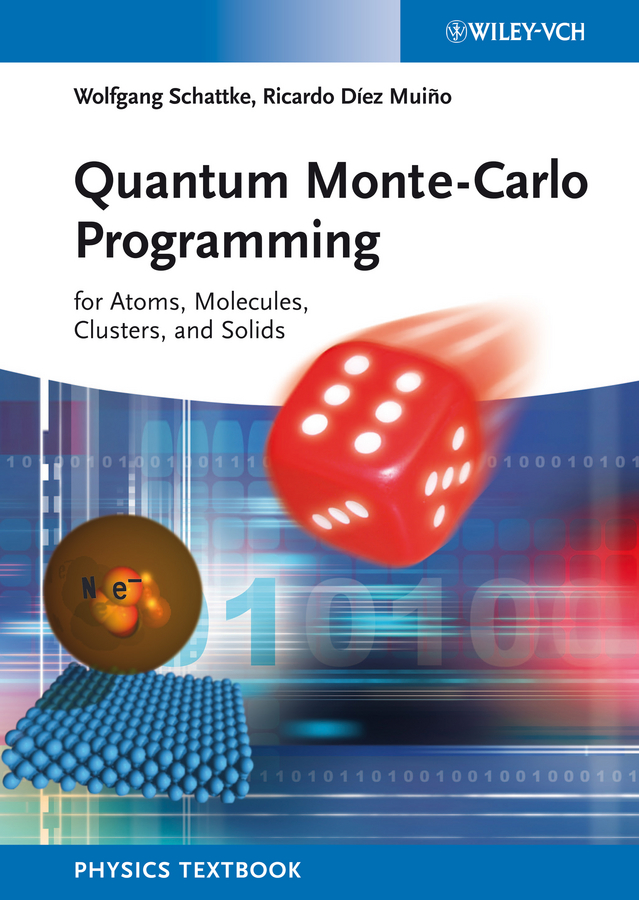
Quantum Monte-Carlo Programming: For Atoms, Molecules, Clusters, and Solids
Schattke, Wolfgang
Díez Muiño, Ricardo
Quantum Monte Carlo is a large class of computer algorithms that simulate quantum systems to solve many body systems in order to investigate the electronic structure of many–body systems. This book presents a numeric approach to determine the electronic structure of atoms, molecules and solids. Because of the simplicity of its theoretical concept, the authors focus on the variational Quantum–Monte–Carlo (VQMC) scheme. The reader is enabled to proceed from simple examples as the hydrogen atom to advanced ones as the Lithium solid. Several intermediate steps cover the Hydrogen molecule, how to deal with a two electron systems, going over to three electrons, and expanding to an arbitrary number of electrons to finally treat the three–dimensional periodic array of Lithium atoms in a crystal. The exmples in the field of VQMC are followed by the subject of diffusion Monte–Calro (DMC) which covers a common example, the harmonic ascillator. The book is unique as it provides both theory and numerical programs. It includes rather practical advices to do what is usually described in a theoretical textbook, and presents in more detail the physical understanding of what the manual of a code usually promises as result. Detailed derivations can be found at the appendix, and the references are chosen with respect to their use for specifying details or getting an deeper understanding . The authors address an introductory readership in condensed matter physics, computational phyiscs, chemistry and materials science. As the text is intended to open the reader?s view towards various possibilities of choices of computing schemes connected with the method of QMC, it might also become a welcome literature for researchers who would like to know more about QMC methods. The book is accompanied with a collection of programs, routines, and data. INDICE: Preface IX 1 A First Monte Carlo Example 1 1.1 Energy of Interacting Classical Gas 1 1.1.1 Classical Many–Particle Statistics and Some Thermodynamics 2 1.1.2 How to Sample the Particle Density? 18 2 Variational Quantum Monte Carlo for a One–Electron System 23 3 Two Electrons with Two Adiabatically Decoupled Nuclei: Hydrogen Molecule 39 3.1 Theoretical Description of the System 39 3.2 Numerical Results of Moderate Accuracy 42 3.3 Controlling the Accuracy 46 3.4 Details of Numerical Program 53 4 Three Electrons: Lithium Atom 61 4.1 More Electrons, More Problems: Particle and Spin Symmetry 63 4.1.1 Antisymmetry and Decomposition of theMany–BodyWave Function 63 4.1.2 Three–Electron Wave Function 65 4.1.3 General Wave Function 67 4.1.4 Relaxing Symmetry of Total Spin 70 4.2 Electron Orbitals for the Slater Determinant 71 4.3 Slater Determinants: Evaluation and Update 76 4.4 Some Important Observables in Atoms? 82 4.4.1 The Module “observables” 87 4.5 Statistical Accuracy 91 4.6 Ground State Results 93 4.6.1 Results for Lithium Atom 93 4.6.2 Code of Main Program, Modules of Variables, of Statistic, of Jastrow Factor, and of Output 103 4.7 Optimization? 115 5 Many–Electron Confined Systems 121 5.1 Model Systems with Few Electrons 121 5.2 Orthorhombic Quantum Dot 122 5.2.1 Confined Single–ParticleWave Functions 122 5.2.2 Details of Program 123 5.2.3 Energy and Radial Density 125 5.2.4 Pair–Correlation Function 131 5.2.5 Program of the Pair–Correlation Function 134 5.3 Spherical Quantum Dot 136 5.3.1 Fundamentals of DFT 137 5.3.2 DFT Calculation of the Jellium Cluster: Methodology 138 5.3.3 QMC Calculation of the Jellium Cluster: Methodology 140 5.3.4 QMC Code for the Calculation of Jellium Clusters 141 5.3.5 Comparison between DFT and QMC Calculations of Jellium Clusters 142 6 Many–Electron Atomic Aggregates: Lithium Cluster 147 6.1 Clusters and Nanophysics 147 6.2 Cubic BCC Arrangement of Lithium Atoms 150 6.2.1 Structure of the Main Program 150 6.2.2 Single–ElectronWave Functions and Structure of the Determinant 150 6.2.3 Geometric Setting of the Cluster 153 6.2.4 Changes in the Program 156 6.3 The Cluster: Intermediate between Atom and Solid 163 6.3.1 1 1 1 Cluster: Li2 164 6.3.2 2 2 2 Cluster 167 6.3.3 3 3 3 Cluster 172 6.3.4 4 4 4 Cluster 174 6.3.5 Cluster Size 178 7 Infinite Number of Electrons: Lithium Solid 181 7.1 Infinite Lattice 183 7.1.1 The Lattices 183 7.1.2 Structure of the Electrostatic Potential 186 7.1.3 Ewald Summation and Tabulation 191 7.1.4 Finite–Size Effects 204 7.2 Wave Function 208 7.2.1 Linear Combination of Atomic Orbitals 208 7.2.2 Plane Waves 210 7.3 Jastrow Factor 212 7.3.1 Standard Choice 213 7.3.2 Principal Ideas and Extensions 215 7.4 Results for the 3 3 3 and 4 4 4 Superlattice Solid 216 8 Diffusion Quantum Monte Carlo (DQMC) 223 8.1 Towards a First DQMC Program 224 8.1.1 Relating Schrödinger Equation to Diffusion 224 8.1.2 Generate Gaussian Random Numbers 228 8.1.3 Application 229 8.1.3.1 Harmonic Oscillator 229 8.2 Conclusion 235 9 Epilogue 237 Appendix 239 A.1 The Interacting Classical Gas: High Temperature Asymptotics 239 A.2 Pseudorandom Number Generators 241 A.3 Some Generalization of the Jastrow Factor 247 A.4 Series Expansion 249 A.5 Wave Function Symmetry and Spin 257 A.5.1 Four Electrons 257 A.6 Infinite Lattice: Ewald Summation 259 A.7 Lattice Sums: Calculation 263 References 269 Index 273
- ISBN: 978-3-527-40851-1
- Editorial: Wiley VCH
- Encuadernacion: Rústica
- Páginas: 296
- Fecha Publicación: 17/07/2013
- Nº Volúmenes: 1
- Idioma: Inglés
